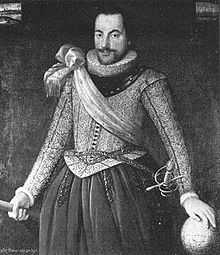Thomas Button
| Sir Thomas Button | |
|---|---|
 | |
| Born | unknown |
| Died | April 1634 |
| Occupation | officer of the Royal Navy and explorer |
Sir Thomas Button (died April, 1634)[1] was a Welsh officer of the Royal Navy and explorer who in 1612–1613 commanded an expedition that unsuccessfully attempted to locate explorer Henry Hudson and to navigate the Northwest Passage.[2] It was, nonetheless, a voyage of discovery and Thomas Button was an explorer as well. Button sailed from England about the beginning of May 1612, in two ships; Resolution and Discovery and reached the mouth of a river which he named the Nelson after a member of the ships company who had died.[3] They wintered at what is now known as Port Nelson and the next year headed north to search for the Northwest Passage. They lost the Resolution to sea ice and continued on to 65° North. He discovered and named Mansel Island and returned to England in September 1613.[4] He is credited with exploring and securing the west coast of Hudson Bay for his country. He named the area New North Wales and New South Wales.
Button was knighted by James I. He continued on to have a successful naval career and became an Admiral, appointed 'Admiral of the King's Ships on the coast of Ireland' for the rest of his career.[5] Despite his standing in the Royal Navy, he had a long quarrel with the English Admiralty which was nearing resolution in his favour at the time of his death.
Button and his men were the first recorded Europeans to walk in the area now known as Manitoba. His discovery meant others followed after him, using his landmarks, his stories, and his detailed notes. The first maps of areas near Hudson Bay were struck from his explorations and from those of his predecessor, Henry Hudson. They were the first Europeans in this area of North America. He was one of the very first Europeans to explore North America in many areas that are now part of Canada. The Nelson River was named by him. Unfortunately he is not well known and acknowledged for his great achievements.
Most of the Hudson Bay Company history is not very well known, even with the vast archives available in Manitoba, Canada. The largest land purchase in Canadian history is due to the Hudson Bay Company holdings, and the first explorers and map makers in the area.
References
- ↑ Lloyd, John Edward; Jenkins, R.T. (1958). The Dictionary of Welsh Biography, Down to 1940. Cardiff: William Lewis. p. 60.
- ↑ "Sir Thomas Button". www.thecanadianencyclopedia.com. Retrieved 2013-09-24.
- ↑ Robert Hood, C. Stuart Houston (1994). To the Arctic by Canoe, 1819-1821: The Journal and Paintings of Robert Hood, Midshipman with Franklin. Google Books. p. 23. ISBN 978-0-7735-1222-1. Retrieved 28 September 2008.
Port Nelson, on the north shore of the peninsula and only twelve miles from York Factory, preceded York as an H.B.C. post in 1682-83. It is at the mouth of the Nelson River, discovered by Sir Thomas Button in 1612 and named after Button's sailing master, who died on the voyage.
- ↑ Robert Hood, C. Stuart Houston (1994). To the Arctic by Canoe, 1819-1821: The Journal and Paintings of Robert Hood, Midshipman with Franklin. Google Books. p. 16. ISBN 978-0-7735-1222-1. Retrieved 28 September 2008.
...named by Button in 1613, after Vice-Admiral Sir Robert Mansel (1573-1653).
- ↑ Evans, C.J.O. (1948). Glamorgan, its History and Topography. Cardiff: William Lewis. p. 147.
External links
- Biography at the Dictionary of Canadian Biography Online
- Manitoba Historical Society Biography of Button